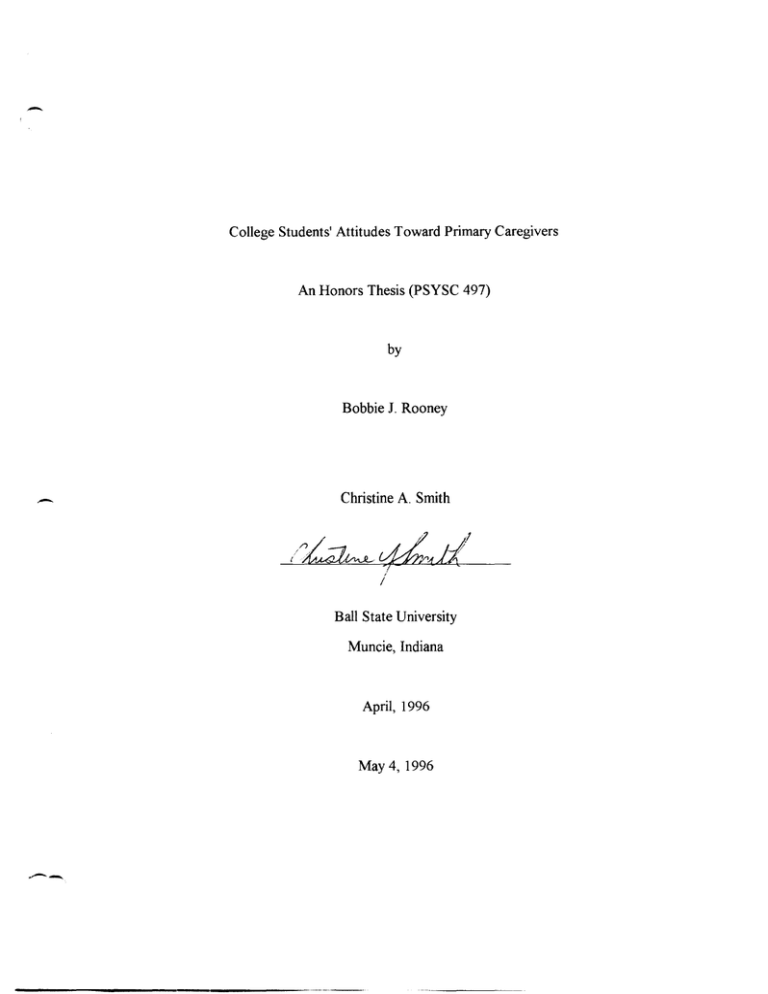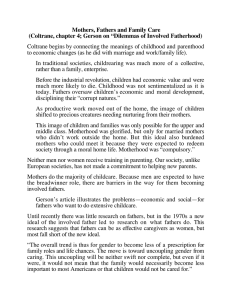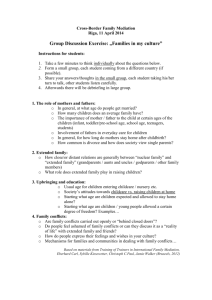-- -
advertisement

College Students' Attitudes Toward Primary Caregivers An Honors Thesis (PSYSC 497) by Bobbie 1. Rooney -- Christine A. Smith ; Ball State University Muncie, Indiana April, 1996 May 4, 1996 -- .- Abstract This study was undertaken in an effort to explore the attitudes of college students toward primary caregivers. The literature review focuses on past research findings, which indicated that mothers have, in the past, been viewed primarily as primary caregivers, and were seen in a negative light when they did not subscribe to this role. Accordingly, predictions were made about the likelihood of mothers being named more often than fathers as primary caregiver and about gender roles of participants being impacted by having had working mothers. Questionnaires were given to a large group of participants, and results of these predictions were analyzed, with no statistically significant findings. A discussion, including anecdotal information from individual participants, follows, offering some interpretations of these results, and suggestions for future research are made. - -- - College Students' Attitudes Toward Primary Caregivers Since John Bowlby and Rene Spitz did their first studies in the 1940s and 1950s on the effects of "maternal deprivation", infant and child caregiving has traditionally been viewed as a mother's role. Mothering has been a role expected of women, a burden imposed upon women and a wonderful opportunity afforded to women. However, more recent research has shown that the most optimal situation for enhanced development in children is not solely reliant upon mother-child interaction, but one in which the child is securely attached to both parents, where both parents take responsibility and are involved in caring for the child and have higher levels of marital satisfaction (Akande, 1994; Scarr, Phillips & McCartney, 1989; Deutsch, Lozy & Saxon, 1993). In fact, women who step outside this "traditional" role, the number of which has skyrocketed to as many as 75% of mothers with school-aged children (u. S. Bureau of Labor Statistics, 1987), are still viewed as less dedicated to their families, less sensitive to the needs of others and less well-adjusted (Etaugh & Nekolny, 1990; Etaugh & Poertner, 1991). According to these studies, women who work are seen as less feminine, more masculine and having generally less desirable characteristics than a full-time homemaker. A national study undertaken by Lauer (1985), estimated that approximately 50% of Americans believe that maternal employment is bad for children. [n a day and age where working women are the norm rather than the exception, and fewer than 7% of families comprise the traditional breadwinner role for fathers and homemaker role for mothers (Braverman, 1989) one must question why these attitudes still exist. The focus of research on this topic over the years has been indicative of the attitudes of the times. During the 1940s and 1950s, research in this area was highly negative, indicating that the role of women was to be their children's primary caretakers. -- Bowlby (1951) and Spitz (1945) asserted that deviations from this "natural" role resulted in severe emotional attachment effects in children. However, Hoffman (1979) points out ,- that Spitz and Bowlby's data was collected during wartime from barren, understaffed institutions, and were then generalized to all children. In the 1960s, research efforts were begun by feminist scholars in an effort to explore the content and significance of motherhood (Lott, 1994, p.218). This wave of research, which has by no means subsided, has been directed at maternal employment and the related issues of child care and how they negatively affect child development. However, the bulk of this research has failed to show consistent negative effects of maternal employment on child development (Silverstein, 1991), In fact, several studies have suggested that on measures of security, self-confidence, and overall emotional adjustment, no differences exist between child-care-reared and home-reared children (Weinraub, Jaeger & Hoffman, 1988). And on the opposite end of the continuum, positive effects of maternal employment on children include less restricted views of sex roles (Hoffman, 1986) and more independence of children in terms of taking - care of their personal needs (Weinraub et aI., 1988). Most recently, though, the effect of the paternal role is being considered (e.g. Pruett, 1983; Yogman, 1987). The term used in this research generally refers to "father absence" as opposed to "maternal deprivation", and the topic is not being as energetically pursued as maternal effects. A search on the Psyclit database found far fewer articles related to fathers and caretaking, as opposed to mothers. One of the factors leading to the perpetuation of the mother's role of primary parent is the belief that men do not have the "instinct" needed to care for a child, This "instinct", or at least the behaviors that lead some to believe it is an instinct, many would argue are for the most part learned (Walsh, 1987). It follows, then, that any man who is taught to nurture and care for children could become as "motherly" as mothers themselves, and research has shown that children do not have an innate sense that women -.- must be their primary caretakers (White, 1981). Parke & Sawin (1975) found that fathers were capable of feeding their infants appropriately and on time. In addition, other - researchers (Banikiotes, Montgomery & Banikiotes, 1972) conditioned three-month-old infants to increase their vocalizations to a tape-recorded voice. The conditioning was found to be just as rapid and effective to a man's voice as to a woman's. Infants have an incredible ability to learn at birth, as evidenced by the latter study, and when considered with the results of the former study, indicate that men are just as capable of attending to children's needs and children will respond to caretakers who are not women. Teti and Gelfand (1991) noted that an individual may have the knowledge needed to console a distressed infant, but may be unable to do so because of self-doubt. Granted, the article was directed at the effects of maternal self-efficacy expectations, but used the term "individual", implying that this statement applies to men as well as women. Not only are fathers capable of caretaking, but interaction with fathers has shown to be beneficial for children's social, mental and motor development (Parke, 1981; Pederson, Zaslow, Suwalsky & Caine, 1980). Parcel and Menaghan (1994) found that fathers' availability to and interaction with their children are important pathways through which children absorb appropriate behavioral norms and develop verbal skills that serve as the foundation for future cognitive attainment. And, the benefits of being an involved father have been clearly identified by Pruett (1993): "Involved fathers have better selfesteem, are less subject to physical illness, have marriages in which their spouses are more satisfied and have children who are better able to adapt to life stresses (p.49)." This statement quite clearly sings the praises of paternal involvement, yet the attitudes toward mothers as primary parents persists. In a recent study done by Bridges and Orza (1993), college students rated a mother who returned to work immediately after a maternal leave of six weeks less favorably than a woman who did not return to work after the birth of her child or a mother who interrupted her employment to stay home with her child for several years. -- Along with the responsibility of child care comes the stress that is a part of it. It has been documented by Kammerman, 1980b, p.36, that of their survey sample with two - or more children, 28% used four to six types of child care per week. According to Silverstein (1991), the stress involved in keeping a system of multiple-care arrangements (i.e. school, babysitter, relative's home) going falls primarily on women. In contrast, the presence of accessible child care and a husband's willingness to share responsibility have been shown to be directly related to decreasing role stress for working mothers. And if the stress weren't enough, mothers are blamed for everything that could go wrong in parenting: "all psychopathology, from simple behavior problems to juvenile delinquency to schizophrenia itself' (Chess and Thomas, 1982, pp. 213-214). As if all of this responsibility for the outcome of their children were not enough, children's gender roles have been hypothesized to be affected by maternal employment. In general, maternal employment has quite positive effects on daughters, but more mixed or negligible effects on sons, especially in middle-class and professional families (Bronfenbrenner and Crouter, 1982). Girls also have higher career aspirations (Hoffman 1974) when their mothers work. Jon Ellis (1994) found that androgynous students were more likely to have had a mother who worked outside the home, and androgyny is related to higher levels of self-esteem for girls (Massad, 1981). In view of the revelations of the more recent research, one would hope that future generations would view child care responsibilities as more egalitarian. This study was undertaken in an effort to examine whether college students, many of whom will be parents someday, have attitudes that reflect the awareness of the beneficial aspects of an equality-based approach to parenting. It is this assumption, based on the previous research, that leads us to make the following predictions: Hypothesis 1: Since women who are homemakers are viewed more positively, mothers should be named more often than fathers as primary caregiver. Hypothesis 2: It was expected that fathers would be named as a caregiving option -- when the child is eight-years-old and mothers will be more often designated as caregiver when the child is a newborn, due to the different style of interaction stereotypical of mothers and fathers. Hypothesis 3: It was expected that mothers instinct would be cited more frequently as an explanation in the newborn scenarios versus the eight-year-old scenarios, due to stereotyping of parenting behaviors. Hypothesis 4: It was expected that participants whose mothers worked outside the home five or more years, whose gender roles should be more flexible, will be more likely to name the father as a caretaker than participants whose mothers worked outside the home less than five years. Hypothesis 5: Participants whose mothers worked outside the home five or more years are more likely to say that neither parent should quit working, due to more flexible gender roles. Method Subjects The participants were 96 female and 85 male undergraduate volunteers who participated for credit in a general psychology class at a Midwestern university. One hundred sixty-eight were white, seven were black, two were Hispanic and three were Asian. One hundred thirty were 18-19,37 were 20-22, 11 were 23-30 and three were over 30. Procedure A female experimenter distributed the questionnaires. The first three sheets of which contained items concerning age, race and gender demographics, as well as more detailed information about family demographics and employment, political views and marital status. The fourth and final page contained one of four scenarios depicting a dualincome couple, one of whom had a high-paying career and received many intrinsic rewards -- from working and whose spouse had an average paying job with average rewards from working. The couple needed to decide on a caregiver for their child, whose age was either - newborn or eight-years-old. These scenarios were manipulated into four categories: 1Wife with high-paying career, newborn child; 2 - Husband with high-paying career, newborn child; 3 - Wife with high-paying career, eight-year-old; 4 - Husband with highpaying career, eight-year-old. Participants read the scenario, then listed up to three caregiving options, answering the question "Why" for each option. A coding scheme was created for responses to the list of caregiving options, as well as for the responses to "Why", with 90% cross-coder reliability. Results Hypothesis 1: Since women who are homemakers are viewed more positively, mothers should be named more often than fathers as primary caregiver. Results of a Chisquare analysis did not support this prediction; 50.6% of the participants named mothers as caregivers, compared with 49.4% naming fathers as caregivers, X2(I,N=83)=2.04, p<.15, ns. Hypothesis 2: It was expected that fathers would be named as a caregiving option when the child is eight-years-old and mothers will be more often designated as caregiver when the child is a newborn, due to the different style of interaction stereotypical of mothers and fathers. Results of a Chi-square analysis did not support this prediction; X2(1,N=95)=.04, Q < .84, ns. Hypothesis 3: It was expected that mothers instinct would be cited more frequently as an explanation in the newborn scenarios versus the eight-year-old scenarios, due to stereotyping of parenting behaviors. So few participants indicated this option (n=3 for newborn scenario, n=2 for eight-year-old scenario) that a reliable statistic could not be computed. Hypothesis 4:. It was expected that participants whose mothers worked outside the home five or more years, whose gender roles should be more flexible, will be more likely to -- name the father as a caretaker than participants whose mothers worked outside the home less than five years. Results of a Chi-square analysis did not support this prediction; X2(1,N=95)=29, 12 < .58, ns. Hypothesis 5: Participants whose mothers worked outside the home five or more years are more likely to say that neither parent should quit working, due to more flexible gender roles. Results of a Chi-square analysis did not support this prediction. X2(,N=166)+ .33, 12 < .56, ns. Discussion In general, the data does not indicate an underlying assumption of mothers being primary caregivers. If anything, these results indicate that many other factors are taken into consideration when people consider who should caregive for children, including financial matters and convenience. Apparently, when these participants made the decision about who should caregive in these scenarios, the sex of the parent did not play an important role in their choice of caregiver. - These participants did not expect either mother or father to interact differently with offspring of varying ages. While the mother-child relationship has, in the past, been viewed as more important during the first few years of life, fathers tend to take a more active role when their children become older, engaging in more rough-and-tumble play. The statistics computed on this data did not find evidence for this assumption, nor was the maternal instinct a popular attribution when responding to the scenarios. Although many responses indicated the traditional role of women (i.e. "show the child how much you care by staying home and becoming a housewife"; "raise it right"), and the importance of the mother-infant bond, mother's instinct was not explicitly stated. Instead, comments were directed more toward females having more effective skills and a "natural" way with children (i.e. "she has better skills for child raising"; "Mothers are better at child raising and it (is) there (sic) place in the home"; "women have a certain level of sensitivity when caring -- for children"; "She should take the natural role" ). - Those participants whose mothers worked outside the home did not have more open ideas about who should caregive in a dual-income couple. This is in direct contrast with a previous study by Signorella, Bigler and Liben (1993), who found that maternal employment was significantly related to nonstereotyped responses on a measure of gender-role development. Also, Etaugh and Study (1989) found that college students' attitudes toward working mothers were more positive when the participants had working mothers, and had more liberal attitudes toward women's roles in general. This was not the case in this study, neither statistically nor deducible from the explanations of some of the participants whose mothers worked outside the home for more than five years, as some of the following comments indicate: "She is a girl so she has to"; "Because she is the mother. She should have considered this when pregnant. She's the one the newborn is attached to"; and "it's her job anyway". It seems that gender roles of these participants did not significantly reflect the ability or desire of both parents to continue working. Participants seemed to give responses on either end of a continuum on this issue. Some chose daycare or other relatives as caregiving options because of the benefits of both parents remaining employed (i.e., "Mom & dad both deserve careers, they earned them ... this is most appealing for me") while others insisted on the psychological benefits to the child of one parent remaining as a primary caretaker (i.e. "I think it is important for one parent to stay home with the child" and" A parent definitely needs to be part of taking care of a newborn"). Many respondents referred to a woman - "I think that the child would be better adjusted if mom could stay at home and take care of him" (Note: sex of the child was not indicated in the scenario.) Given that mothers who are homemakers have, in the past, been viewed more positively than mothers who work (Bridges and Orza, 1993) a logical deduction would be -- that mothers would be designated caregiver more often. However, this data does not support this hypothesis. Apparently, these participants, many of whom do not yet have - children, do not see the mother's role as a given, or even a desirable, but see caregiving more as a matter of convenience, with 8% of participants indicating this in their answers, or as a financial issue, receiving mention by 6.2% of the participants. These incongruous results could mean that the majority ofthese future parents are aware of the benefits of both parents being involved with their children, or are more aware of the likelihood that both parents will be working, as a result seeing child care as a more equal responsibility between the mother and father. Fathers also seem to be expected to have the ability to care for their children. Some comments regarding this issue include "He may enjoy staying at home and fathers should be just as much as a part of the child's life" Limitations abound in this study, the most salient being that this is merely a paper and pencil survey, and might not necessarily be representative of what people might do in their lives. There may be some discrepancy between what people say and what they actually do in their lives. Also, a more extensive list of questions regarding attitudes would be in order, one that examines views on parenting, working, and feminism. In addition, perhaps the indication of the high-paying career in law created attributions about the type of person who might engage in this career, thereby decreasing likelihood that this person should cease working. A more ambiguous career may produce results that are more consistent with previous findings. If these results can be taken at face value, and if replication occurs and congruent findings are obtained, one must then question why society continues to reward stay-athome mothers, while not providing necessary support and resources for working women. Magazine articles continue to give mothers ideas for balancing working, taking care of the home and coordinating child care, yet articles addressing these issues are virtually nonexistent in men's magazines. Television sitcoms and commercials still depict women in caregiving roles, and mothers are still blamed for the outcome of their children's -- personalities. - Research efforts aimed at uncovering stereotypical attitudes and efforts to reduce these stereotypes in future studies, in combination with more bold researchers questioning the status quo and not allowing gender stereotypes to persist in psychological research, one can have hope that the situation will improve. If not for the working women of my generation, then perhaps for my daughters and their children. -- - References Akande, A (1994). What meaning and effects does fatherhood have in child development? Early Child Development and Care, 101, 51-58. Bowlby, J. (1951). The nature of the child's ties to his mother. International Journal of Pc\ychoanalysis, 39, 350-373. Braverman, L.B. (1989). Beyond the myth of motherhood. In M. McGoldrick, C.M. Anderson, & F. Walsh (Eds.), Women and Families (pp.227-243). New York: Free Press. Banikiotes, F.G., Montgomery, AA, & Banikiotes, P.G. (1972). Male and female auditory reinforcement of infant vocalizations. Developmental Psychology, 6,476-481. Bridges, lS., & Orza, AM. (1993). Effects of maternal employment-childrearing pattern on college students' perceptions of a mother and her child. Psychology of Women Quarterly, 17, 103-117. Bronfenbrenner, A, & Crouter, AC. (1982). Work and family through time and space. In S. Kamerman and C. Hayes (Eds.), Families that work: Children in a changing world (pp.39-83). Washington, D.C.: National Academy Press. Chess, S., & Thomas, A (Eds.)(1982). Infant bonding: Mystique and reality. American Journal of Orthopsychiatry, 52, 213-222. Deutsch, F.M., Lozy, lL., & Saxon, S. (1993). Taking credit: Couples' reports of contributions to child care. Journal of Family Issues, 14, 421-437. Etaugh, C., & Nekolny, K. (1990). Effects of employment status and marital status on perceptions of mothers. Sex Roles, 23, 273-280. Etaugh, C., & Poertner, P. (1991). Effects of occupational prestige, employment status, and marital status on perceptions of mothers. Sex Roles, 24, 345-354. Etaugh, -- c., & Study, G. G. (1989). Demographic predictors of college students' attitudes toward working mothers. Journal o/College Student Development, 30,465466. - Ellis, J.B. (1994). Children's sex-role development: Implications for working mothers. Social Behavior and Personality, 22, 131-136. Hoffinan, L.W. (1974). Effects of maternal employment on the child: A review of the research. Developmental Psychology, 10, 204-228. Hoffinan, L.W. (1979). Maternal employment, 1979. American Psychologist, 34, 859-865. Hoffman, L.W. (1986). Work, familiy and the child. In M.S. Pallak and R.O. Perloff (Eds.), Psychology and work: Productivity, change and employment (pp. 173220). Washington, D.C.: American Psychological Association. Kamerman, S.B. (1980b). Parenting in an unresponsive society. New York: Free Press. Lauer, H. (1985). Jobs in the 1980s: A sourcebook for policymakers. In D. Yankelovich, H. Zetterberg, B. Strumpel, & M. Shanks (Eds.), The world at work (pp.237-407). New York: Octagon Books. Lott, B. (2nd ed.) (1994). Women's lives: Themes and variations in gender learning (pp.222-237). Pacific Grove, CA: Brooks/Cole. Massad, C. (1981). Sex-role identity and adjustment during adolescence. Child Development, 52, 1290-1298. Parcel, T.L., & Menaghan, E.G. (1994). Early parental work, family social capital, and early childhood outcomes. American Journal of SOCiology, 99, 972-1009. Parke, R. (1981). Fathers. Cambridge, MA: Harvard University Press. Parke, R., & Sawin, D. (1975). Infant characteristics and behavior as elicitors of maternal and paternal responsiveness in the newborn. Paper presented at the Society for Research in Child Development, Denver. Pedersen, F., Zaslow, N., Suwalsky, l, & Caine, R. (1980). Parent-infant and -- husband-wife interactions observed at five months. In F. Pedersen (Ed.), The father-infant relationship (pp.65-91). New York: Praeger. - Pruett, K.D. (1983). Infants of primary nurturing fathers. The Psychoanaltyic study o/the child, 40, 257-277. Pruett, K.D. (1993). The paternal presence. Families in Society, 74, 46-50. Scarf, S., Phillips, D., & McCartney, KI. (1989). Working mothers and their families. American Psychologist, 44, 1402-1409. Signorella, M.L., Bigler, R.S., & Liben, L.S. (1993). Developmental differences in children's gender schemata about others: A meta-analythic review. Developmental review, 13, 147-183. Silverstein, L.B. (1991). Transforming the debate about child care and maternal employment. American Psychologist, 46, 1025-1032. Spitz, R.A. (1945). Hospitalism: An inquiry into the genesis of psychiatric conditions in early childhood. In RS. Eissler (Ed.), The psychoanalytic study o/the child (Vol. I). New York: International Universities Press. Teti, D.M. & Gelfand, D.M. (1991). Behavioral competence among mothers of infants in the first year: The mediational role of maternal self-efficacy. Child Development, 62, 918-929. U.S. Bureau of Labor Statistics (1987) Statistical abstract of the United States (107th ed.). Washington, D.C.: U.S. Department of Commerce. Walsh, M.R (Ed.) (1987). The psychology of women: Ongoing debates. Binghamton, N.Y.:VaillBallou. Weinraub, M., Jaeger, E., & Hoffman, L.W. (1988). Predicting infant outcomes in families of employed and non-employed mothers. Early childhood research quarterly, 3, 361-378. White, B.L. (1981). Should you stay home with your baby? In M.R Walsh (Ed.), The psychology of women: Ongoing debates. Binghamton, N. Y.: VaillBallou. - - Yogman, M. (1987). Father-infant play with pre-term and full-term infants. In F. Pedersen & P. Berman (Eds.), Men's transitions to parenthood: Longitudinal studies of early family experiences (pp.97-114). New York: Erlbaum . - .






